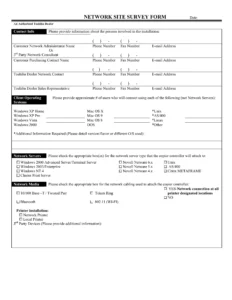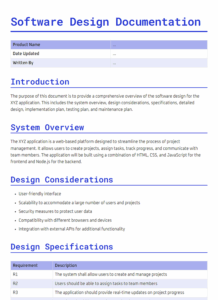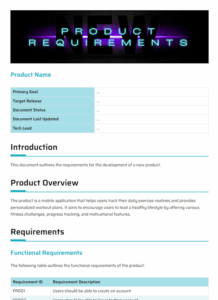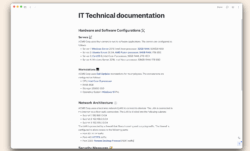Ever felt like your IT infrastructure is a tangled mess of cables and software versions? You’re not alone! In today’s complex digital landscape, keeping track of every single component of your IT systems is vital for smooth operations, quick problem-solving, and overall efficiency. That’s where configuration management comes in. Think of it as the blueprint for your entire IT ecosystem, ensuring everyone knows exactly what’s where and how it’s connected.
But where do you even begin? Creating configuration management documentation from scratch can be a daunting task. Fear not! A configuration management documentation template is your secret weapon. It provides a structured framework to capture all the essential details about your IT assets, from hardware and software to network settings and security protocols. It ensures consistency, accuracy, and accessibility across your entire team. It is a foundation for repeatable processes.
This article will explore the importance of configuration management documentation, the benefits of using a template, and what key elements it should include. We’ll also provide practical tips and insights to help you create a template that works for your specific organization, regardless of size or complexity. By the end, you’ll be well-equipped to conquer the chaos and take control of your IT configuration with confidence.
Why is Configuration Management Documentation Important?
Imagine trying to fix a broken server without knowing its operating system, installed software, or network configuration. It would be like trying to solve a puzzle with missing pieces. Configuration management documentation eliminates this guesswork by providing a single source of truth for all your IT assets. It ensures that everyone on your team is on the same page, which leads to faster troubleshooting, reduced downtime, and improved collaboration. In essence, it is a roadmap for your IT.
Detailed and well-maintained documentation is essential for change management. When implementing changes to your IT systems, such as software upgrades or hardware replacements, you need to understand the potential impact of those changes. Configuration management documentation provides the necessary information to assess risks, plan deployments, and ensure that changes are implemented smoothly and without disrupting critical services. If you have a change management board, they can easily find information in one place.
Furthermore, it plays a crucial role in compliance and auditing. Many industries are subject to regulatory requirements that mandate proper management and documentation of IT assets. Configuration management documentation helps you demonstrate compliance with these regulations by providing a clear audit trail of all changes made to your systems. This can save you time, money, and headaches during audits.
Beyond the practical benefits, comprehensive configuration management documentation fosters a culture of accountability and transparency within your IT organization. It empowers team members to take ownership of their systems and responsibilities, knowing that they have access to the information they need to do their jobs effectively. It also promotes knowledge sharing and reduces reliance on individual experts, which can be especially important during employee turnover.
In a nutshell, ignoring configuration management documentation is like navigating a ship without a map or compass. You might get lucky for a while, but eventually, you’re bound to run aground. Investing in creating and maintaining proper documentation is an investment in the long-term stability, security, and efficiency of your IT infrastructure. A good configuration management documentation template can alleviate the problem.
Key Elements of a Configuration Management Documentation Template
A good configuration management documentation template should capture all the essential details about your IT assets in a clear, consistent, and easily accessible format. Here are some key elements to consider including:
Asset Identification: Each IT asset should be uniquely identified with a name, serial number, or other identifying information. This allows you to easily track and manage individual assets throughout their lifecycle.
Asset Type and Description: Clearly specify the type of asset (e.g., server, workstation, router, software application) and provide a detailed description of its purpose and function within your IT environment.
Configuration Details: This is the heart of your documentation. Capture all relevant configuration details, such as operating system version, installed software, network settings, security protocols, and hardware specifications. The level of detail will depend on the specific asset and its criticality to your business.
Location and Ownership: Document the physical location of the asset (e.g., data center, office, cloud region) and identify the individual or team responsible for its maintenance and support. This helps to ensure accountability and facilitates communication during troubleshooting and maintenance activities.
Change History: Keep a detailed record of all changes made to the asset’s configuration, including the date, time, and reason for the change, as well as the individual or team who made the change. This provides an audit trail of all configuration modifications and helps to identify the root cause of any issues that may arise.
Dependencies: Document any dependencies that the asset has on other IT systems or components. This is crucial for understanding the potential impact of changes and for ensuring that all necessary components are updated or maintained in a coordinated manner.
Backup and Recovery Procedures: Clearly outline the backup and recovery procedures for the asset, including the frequency of backups, the location of backup files, and the steps required to restore the asset in the event of a failure.
By including these key elements in your configuration management documentation template, you can create a comprehensive and reliable record of your IT infrastructure, which will help you to improve efficiency, reduce risk, and ensure compliance.
Having the right configuration management documentation template is only the first step. Remember that the process of updating your documentation must be consistent. Consider using automation tools to make your life easier.
Ultimately, taking control of your IT infrastructure is an investment in your company. With the right processes and tools, you can set yourself up for a more efficient, secure, and reliable future.



